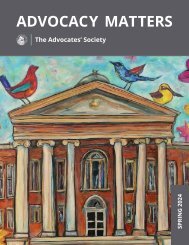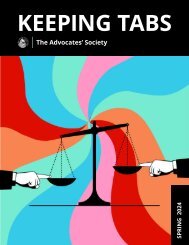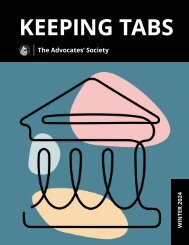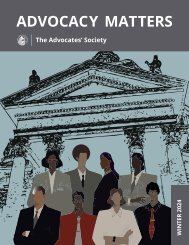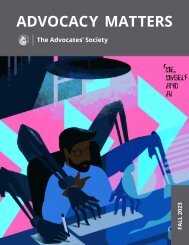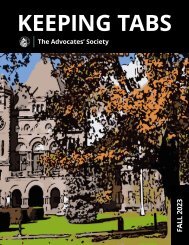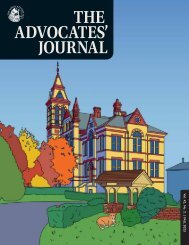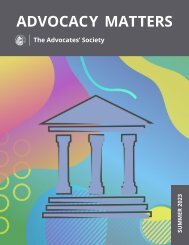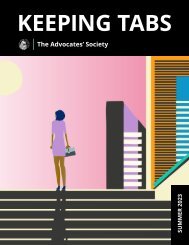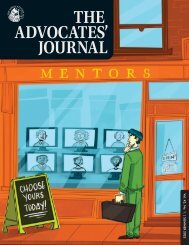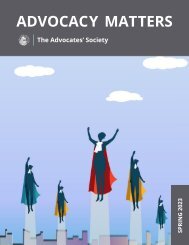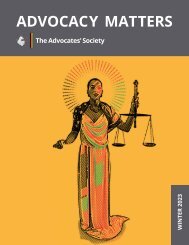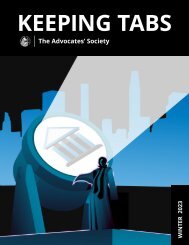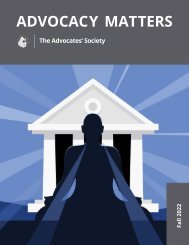Advocacy Matters Winter 2020
Keep up to date on what your fellow Society members have to say in Advocacy Matters.
Keep up to date on what your fellow Society members have to say in Advocacy Matters.
You also want an ePaper? Increase the reach of your titles
YUMPU automatically turns print PDFs into web optimized ePapers that Google loves.
ADVOCACY MATTERS<br />
The Advocates’ Society<br />
WINTER <strong>2020</strong>
Donate Your Rate<br />
to support Pro Bono Canada<br />
Our Donate Your Rate TAS Gives Back campaign asks members to donate<br />
just 15 minutes of their billable rate to Pro Bono Canada. Our collective<br />
power has the ability to raise hundreds of thousands of dollars to make a<br />
difference for Canadians in need of access to justice.<br />
Visit www.advocates.ca to Donate Your Rate today!<br />
05<br />
07<br />
10<br />
What the TWEET is this?<br />
When you see this icon, throughout the publication,<br />
click on it to see what members are tweeting about.<br />
CONTENTS<br />
Chair Chat<br />
Hilary Book, Book Law<br />
Equality In The Profession<br />
Yola S. Ventresca and Debbie Boswell, Lerners LLP (London)<br />
10+ Events<br />
Cynthia Spry, Babin Bessner Spry LLP<br />
13<br />
17<br />
21<br />
24<br />
26<br />
Mentoring<br />
Sayeh Hassan, Walter Fox & Associates<br />
Journal Review: Then and Now<br />
Christine Vanderschoot, Vanderschoot Family Law<br />
Quirky Case<br />
Tamara Ramsey, Dale & Lessmann LLP<br />
Criminal Bar (Alberta)<br />
Tamara Prince, Osler, Hoskin & Harcourt LLP<br />
Interview<br />
Compiled by Andrew Gibbs, Department of Justice Canada<br />
Editor: Brent J. Arnold, Gowling WLG (Canada) LLP<br />
The opinions expressed by individual authors are their own and do not necessarily reflect the policies of The Advocates’ Society.<br />
3
COMING UP<br />
(Click on the program to learn more)<br />
CHAIR CHAT<br />
MAR 10<br />
Thunder Bay<br />
Courthouse:<br />
Getting To the Point<br />
(Thunder Bay)<br />
MAR 11<br />
Barrie Courthouse:<br />
Getting To the Point<br />
(Barrie)<br />
MAR 12<br />
Trivia Challenge<br />
for Charity<br />
(Toronto)<br />
Chair Chat<br />
Hilary Book, Book Law<br />
MAR 25<br />
Young Advocates’<br />
Peel Social<br />
(Brampton)<br />
MAR 27<br />
Business<br />
Development for<br />
Litigators Part 2<br />
(Toronto)<br />
MAR 25<br />
Troisième Édition<br />
Du Pub Night<br />
Montreal<br />
(Montreal)<br />
MAR 31<br />
Defamation Law:<br />
What Litigators<br />
Need To Know<br />
(Toronto)<br />
MAR 26<br />
Waterloo Region<br />
Social<br />
(Kitchener)<br />
MAR 26<br />
Windsor<br />
Courthouse:<br />
Getting To the Point<br />
(Windsor)<br />
MAR 26<br />
Young Advocates’<br />
Windsor Social<br />
(Windsor)<br />
The days are getting longer, the sun is getting<br />
warmer. Some day soon, the robins will return,<br />
the flowers will come out (quiet those of you in<br />
B.C. who have already been enjoying them for<br />
weeks), and it will be time to do our taxes. Ah,<br />
the return of spring!<br />
Taxes – payroll remittances, partnership instalments,<br />
T4s, HST returns – are just some of<br />
the business issues that many mid-career litigators<br />
have to deal with. Knowing how to run a<br />
business (and how to deal with the business aspects<br />
of partnership) is critical to the success of<br />
all of us in private practice, and can be a major<br />
source of stress, but it’s an area where we often<br />
get little training or mentoring.<br />
This term, the 10+ Committee is putting on a<br />
series on the business of law (chaired by Steve<br />
Frankel) that aims to educate and provide a forum<br />
for discussion on all of those sexy topics<br />
like cash flow, collections, partnership structures,<br />
etc. that we so rarely talk about outside<br />
the confines of our offices. Our last event on<br />
February 12 focused on whether or not to incorporate,<br />
and it was great to see so many of<br />
you come out and really engage with the panel.<br />
10+ has lots more in store for this year, and planning<br />
is already underway on some exciting new<br />
initiatives for next year. Please continue to come<br />
out to our events, contribute articles to <strong>Advocacy</strong><br />
<strong>Matters</strong>, and send us your ideas for how we can<br />
continue to develop programs and initiatives to<br />
better serve the needs of mid-career advocates.<br />
Our <strong>Advocacy</strong> <strong>Matters</strong> team continues to do<br />
an excellent job putting this publication together<br />
every quarter. This issue includes Andrew<br />
Gibbs’ interview with litigation superstar Audrey<br />
Boctor, Yola Ventresca on pay equity and Sayeh<br />
Hassan on the importance of mentoring. Also<br />
in this issue are reports on Calgary’s <strong>Advocacy</strong><br />
on the Front Lines and Ottawa’s President’s Reception.<br />
Last but not least, this issue includes<br />
a new feature that takes a look back to an old<br />
TAS article to see how things have changed,<br />
and how they remain the same. This month,<br />
Christine Vanderschoot takes a look at Franklin<br />
Moskoff, Q.C.’s 1994 article on the right to trial<br />
within a reasonable time.<br />
We are always looking for new contributors<br />
to <strong>Advocacy</strong> <strong>Matters</strong> so that we can continue<br />
to bring you interesting articles from diverse<br />
perspectives. Please contact Editor Brent Arnold at<br />
Brent.Arnold@gowlingwlg.com or Assistant Editor<br />
Tamara Ramsey at tramsey@dalelessmann.com<br />
to learn more!<br />
5
Get Involved<br />
with YASC<br />
The Young Advocates’ Standing Committee<br />
seeks engaged, hard-working volunteers to<br />
promote the interests of young advocates<br />
(lawyers ten years of call or fewer) through<br />
planning and implementing mentoring/<br />
networking programs, administering YASC’s<br />
publication by and for young advocates<br />
(Keeping Tabs) and participating in the work<br />
of The Advocates’ Society.<br />
The Society welcomes applications to YASC<br />
from Society members who are ten years of<br />
call or fewer. Successful applicants will serve<br />
a two-year term starting May <strong>2020</strong> (subject<br />
to re-application). Parental leave will be<br />
accommodated. DEADLINE EXTENDED TO<br />
MARCH 6, <strong>2020</strong>.<br />
To apply for YASC <strong>2020</strong>/21 term click here.<br />
Questions? Please contact Christopher Horkins<br />
at chorkins@casselsbrock.com<br />
EQUALITY IN THE PROFESSION<br />
Unfortunately, the obvious<br />
needs to be stated (again):<br />
pay equity and the<br />
practice of law.<br />
Yola S. Ventresca and Debbie Boswell,<br />
Lerners LLP (London)<br />
Facts, the saying goes, are stubborn things. And the facts make clear that, for all the seeming<br />
advances made in recent decades by women in law, serious pay inequities remain between<br />
men and women lawyers. Not surprisingly, pay inequities emerge at the very start of practice.<br />
According to Ronit Dinovitzer, an Associate Professor of Sociology at the University of Toronto,<br />
a national study of recent Canadian law graduates found that across all legal settings, women<br />
6 7
working full-time earn 93% of men’s salaries<br />
(median earnings of $75,000 for women compared<br />
with $80,500 for men).<br />
Some of this difference can be explained by<br />
the legal settings in which men and women<br />
tend to work. Women outnumber men in the<br />
public sector, where base salaries tend to be<br />
lower. By contrast, there are more men than<br />
women in the largest private law firms, where<br />
salaries are highest.<br />
But the setting in which new lawyers practise<br />
does not, in itself, account for gender-based pay<br />
inequities in law. Even in large private law firms,<br />
women’s earnings are only 91% of their male<br />
colleagues. In an interview with Precedent magazine,<br />
Professor Dinovitzer suggests that this<br />
gender disparity at large law firms likely comes<br />
from bonuses rather than base salaries. If partners<br />
put their male junior associates on more lucrative<br />
files, those male associates may bill more<br />
hours or be making other contributions that are<br />
privileged and valorized by prevailing firm culture.<br />
This results in higher compensation in the<br />
form of higher bonuses, not to mention future,<br />
ever-more lucrative opportunities for professional<br />
advancement and increased earnings.<br />
“If women are systematically kept off these<br />
files,” Dinovitzer concludes, “they’ll earn smaller<br />
bonuses.”<br />
We need a serious, frank conversation<br />
about the reasons why male junior associates<br />
often enjoy privileged access to the<br />
most lucrative opportunities. Some of<br />
these reasons are obvious enough, if rarely<br />
acknowledged. The assumption, for instance,<br />
that female junior associates will be<br />
on maternity leave, or could be, potentially<br />
for lengthy periods of time; or that women<br />
lawyers will prioritize their roles as caregivers<br />
over the demands of the most challenging<br />
and lucrative files.<br />
It goes without saying – or it should – that<br />
such assumptions are sexist and anachronistic,<br />
and yet also powerful attitudinal forces<br />
that create and sustain pay inequities across<br />
the profession.<br />
Indeed, a look at the situation in the wider<br />
legal profession reveals that glaring gender<br />
gaps remain. Again, these speak to the persistence<br />
of stubborn structural and attitudinal<br />
barriers to women in law – barriers that<br />
account for, and help to sustain, systemic disparities<br />
in pay equity.<br />
Women are underrepresented at senior<br />
levels in the legal profession – positions that<br />
bring with them the most lucrative salaries. According<br />
to a recent study by the Toronto Star,<br />
women make up 30% or less of the partnership<br />
at large law firms in Ontario. By contrast,<br />
women comprise nearly 50-60% of associates<br />
at the same law firms. Even for those women<br />
who do become partners, gender differences<br />
remain. A 2002 study found male partners<br />
earned $296,830 on average, compared with<br />
$263,549 for female partners.<br />
Gender wage disparity exists elsewhere in the<br />
legal profession. The 2018 In-House Counsel<br />
Compensation & Career Survey Report found<br />
that for in-house counsel, the average salary<br />
for women is 11% lower than men in 2018<br />
($173,000 on average for men, compared with<br />
$154,000 for women).<br />
Gender pay disparities are often interconnected<br />
with other issues that impact female lawyers,<br />
such as opportunities for advancement,<br />
attrition from large law firms, and the inequitable<br />
division of childcare responsibilities. These<br />
are broad, systemic issues that the profession<br />
needs to address.<br />
The persistence of pay inequity should be<br />
front-of-mind in our own practice and career<br />
trajectories. For positions where salaries are<br />
negotiable, research salaries, talk with your<br />
colleagues, and be prepared to negotiate.<br />
Our role as lawyers is to be advocates for<br />
our clients, but we also need to ensure we’re<br />
being advocates for ourselves and what we<br />
bring to the table.<br />
What is more, the recognition that pay inequities<br />
persist, and a commitment to remedy gender<br />
disparities once and for all ought to be a<br />
priority for the whole of the profession.<br />
8 9
10+ EVENTS<br />
Business for Litigators<br />
Cynthia Spry, Babin Bessner Spry LLP<br />
On November 20, 2019, the 10+ Standing Committee hosted its first “Management for Litigators”<br />
event. This series is intended to address business issues faced by mid-career advocates,<br />
whether developing our own practices within a larger firm, running our own small firms, participating<br />
in management as a partner in a law firm, or hoping to become one. Sean Bailey (PwC),<br />
Ranjan Agarwal (Bennett Jones), and I (Babin Bessner Spry) formed the panel, which was skillfully<br />
moderated by Steven Frankel (Davies).<br />
We had a great turnout, and an interesting and frank discussion about the inner workings of<br />
our firms, both large and small. We discussed<br />
the challenges in transitioning from associate<br />
to partner, the importance of financial literacy,<br />
how to ensure the financial health of our practices,<br />
how to fund a law firm (accounts receivable,<br />
capital injection, line of credit, or a combination<br />
of these), best practices for taking new matters,<br />
and signs that it is time to fire the client.<br />
Key takeaways from the event included:<br />
- Set up the file properly in the first place,<br />
with a comprehensive retainer letter and<br />
sufficient monetary retainer to cover the<br />
first month or stage of the file (don’t get<br />
stiffed on injunctions);<br />
- When running a business, large or small,<br />
cash flow matters, so docket your time daily,<br />
bill monthly, and follow up regularly on accounts<br />
receivable;<br />
- Build your networks – sometimes it can be<br />
easier or more effective to ask for input from<br />
outside your firm, and your contacts will be<br />
happy to help you;<br />
- When building your own book of business,<br />
don’t be afraid to turn down work<br />
you don’t want, or clients who don’t seem<br />
prepared to pay;<br />
- Think carefully about taking files on contingency<br />
– there may be an emotional, social,<br />
or moral reason to do so, but taking all the<br />
risk on a file means you usually have to double<br />
or triple your time spent at your hourly<br />
rate to make it pay;<br />
- Look at your book of business on at least<br />
a yearly basis, and don’t be afraid to fire the<br />
clients who are making you miserable.<br />
The event was generously sponsored by Arbitration<br />
Place. The second event took place on<br />
February 12, <strong>2020</strong>, where panelists discussed<br />
the pros and cons of practising through a professional<br />
corporation (report on that in the<br />
next issue) and a final session is being planned<br />
for May <strong>2020</strong>.<br />
10 11
Get Involved<br />
with 10+<br />
The 10+ Standing Committee seeks engaged<br />
and committed volunteers to promote the<br />
interests of mid-career advocates through<br />
planning and implementing information<br />
and networking events, administering the<br />
<strong>Advocacy</strong> <strong>Matters</strong> newsletter and participating<br />
in the work of The Advocates’ Society.<br />
The Society welcomes applications to the<br />
10+ SC from Society members who are in<br />
the range of 8 to 17 years of call. Successful<br />
applicants will serve a two-year term starting<br />
May <strong>2020</strong> (subject to re-application). Parental<br />
leave will be accommodated.<br />
Deadline: March 11, <strong>2020</strong>.<br />
To apply for the 10+ Standing Committee<br />
<strong>2020</strong>/21 term click here.<br />
Questions? Please contact Yola Ventresca at<br />
yventresca@lerners.ca<br />
MENTORING<br />
Mentorship:<br />
A View from the Criminal Bar<br />
Sayeh Hassan, Walter Fox & Associates<br />
I have practised criminal defence law for over<br />
12 years, and from the very beginning was fortunate<br />
to have an incredible mentor who supported<br />
my growth and development both as a<br />
lawyer and as a person by encouraging me every<br />
step of the way.<br />
Being a criminal defence lawyer can be extremely<br />
difficult and very lonely at times. Having<br />
a mentor to rely on both in good times and bad<br />
times has been a blessing which has motivated<br />
me to do the same for other law students and<br />
newly called lawyers. I do this by participating in<br />
various mentorship and coaching programs, including<br />
the LPP Mentorship & Work Placement<br />
Program, LSO’s CanCoach program, mentoring<br />
students who article for our firm, and speaking<br />
at law schools to aspiring lawyers.<br />
My experiences have helped me gain new<br />
insight into the world of mentorship and have<br />
taught me two important lessons.<br />
12 13
1) Mentorship relationships are like a circle<br />
where mentors and mentees are connected<br />
in a mutually beneficial relationship supporting<br />
and learning from each other.<br />
For many years my mentor told me that I was<br />
“mentoring” him as well, but I never understood<br />
how this could be; how could I be mentoring<br />
someone with over 50 years of experience in<br />
criminal law, who in my eyes already knew everything<br />
there was to know? However, over the<br />
years I have come to realize that mentorship is<br />
a lot more than talking about the law or career<br />
development.<br />
Sometimes, mentorship is about having someone<br />
to talk to when you’ve had a terrible day in<br />
court and you need to vent, or talk about what<br />
didn’t go your way, or even just when you want<br />
to be miserable and sulk in that moment.<br />
As defence lawyers we are constantly in the<br />
trenches, fighting for the rights of our clients<br />
against a powerful and resourceful state. Despite<br />
our best efforts, sometimes we lose and<br />
our clients are convicted and go to prison. That’s<br />
a heavy burden to bear for any lawyer, but especially<br />
for a newly called lawyer who may feel<br />
responsible for the outcome of the case.<br />
That has certainly been the case for me. I remember<br />
a particular sexual assault case where<br />
my client was convicted in the Superior Court in<br />
a case where I believed there was ample doubt<br />
and my client would be acquitted. My client was<br />
sentenced to 20 months in jail. I was devastated<br />
and blamed myself.<br />
After the conviction and sentencing I talked to<br />
my mentor about how I felt. He listened attentively;<br />
he told me that I was a good lawyer and<br />
that it wasn’t my fault. He even took the time to<br />
review the transcripts and point out the strong<br />
points I had made during the trial. Most importantly,<br />
he refused to let me blame myself. In<br />
return, there have been times when I’ve “mentored”<br />
my mentor by listening to his frustrations<br />
about a case, and helping him calm down and<br />
deal with the situation at hand.<br />
2) A mentor is someone who encourages<br />
you, believes in you, and helps you step out<br />
of your comfort zone.<br />
This is a less talked-about aspect of mentorship<br />
because so much of mentorship focuses<br />
on either on specifics aspect of the law or of<br />
career development. But, in my experience as<br />
a mentee and a mentor, sometimes all a mentee<br />
needs is some encouragement, someone<br />
to believe in them and encourage them to follow<br />
their dreams.<br />
When I started my career in criminal defence<br />
I was extremely shy and at times insecure. I<br />
struggled with wanting my work to be “good”<br />
but being unsure if it actually was.<br />
I was finally able to overcome both my shyness<br />
and doubts through the encouragement<br />
of my mentor who kept telling me “Sayeh you’re<br />
a good lawyer.” In fact, he often made me repeat<br />
it after him. Eventually, it started to sink in.<br />
The legal profession is highly competitive and<br />
while one may be able to find a senior lawyer to<br />
provide legal guidance on a specific issue, many<br />
people just starting to get into the profession<br />
are faced with negativity and a doom and gloom<br />
mentality. I see the same insecurities I had early<br />
on in my career in many law students and newly<br />
called lawyers who are just starting out.<br />
In my mentorship/mentee relationships I do<br />
my best to encourage them and help them see<br />
their own potential. I have seen people’s faces<br />
light up when I point out things they’ve accomplished<br />
that for some reason they didn’t think<br />
were important or significant. I’ve seen my mentees<br />
significantly improve their advocacy skills<br />
through encouragement and positive feedback.<br />
Through mentorship I’ve gained support and<br />
encouragement, learned from different people<br />
and their wide variety of experiences and have<br />
developed life long relationships with many<br />
wonderful people. This is why I would highly<br />
recommend becoming a mentor to anyone who<br />
is in a position to offer support, help and encouragement<br />
to colleagues.<br />
14 15
The Advocates’<br />
Society<br />
Annual Gala<br />
Thursday, April 2, <strong>2020</strong><br />
The Fairmont Palliser,<br />
133 9th Avenue SW, Calgary, AB<br />
Trade your tabs for fancy frocks and join<br />
members of the bench and bar for an exclusive<br />
evening of collegiality for the litigation bar.<br />
Keynote Speaker:<br />
The Honourable Marshall E. Rothstein, C.C., Q.C.,<br />
Osler, Hoskin & Harcourt LLP<br />
To learn more or register visit<br />
www.advocates.ca<br />
JOURNAL REVIEW: THEN AND NOW<br />
An Advocate’s Perspective<br />
20 years before R. v. Jordan<br />
Christine Vanderschoot, Vanderschoot Family Law<br />
In this feature, I will select and review an article from The Advocates’<br />
Journal from 20 years ago. In this issue, I have selected an article by<br />
Franklin Moskoff, Q.C. from the Summer 1994 edition.<br />
Signature Sponsors:<br />
Supporters:<br />
In the Summer ’94 edition of the Advocates’ Society Journal, the issue of an accused’s right to trial<br />
within a reasonable time was the main topic in the feature article by Franklin Moskoff, Q.C. While<br />
the article, titled Section 11(b) 1 of the Canadian Charter of Rights and Freedoms and Problems<br />
in the Application of the Doctrine of Abuse of Process, was written 22 years before the Supreme<br />
Court of Canada’s transformative decision in R. v. Jordan 2 , Moskoff was prescient in anticipating<br />
that section 11 (b) Charter decisions would lead to uncertainty in how the doctrine of abuse of<br />
process would be applied.<br />
The Charter had an almost immediately perceptible impact on the court’s ability to overcome any<br />
16 17
lack of statutory provisions when making a finding<br />
on whether or not there had been an abuse<br />
of process. But even with the Charter in place,<br />
problems continued, as Moskoff illustrates. He<br />
focuses on specific examples of cases that were<br />
still being decided on a largely ad hoc basis, with<br />
judges choosing to use or not use their discretion<br />
to find an abuse of process where the pace<br />
of proceedings was at issue.<br />
For example, Moskoff compares the decision in<br />
Regina v. Young to the outcome in Regina v. Miles<br />
of Music Ltd. for a particularly stark contrast in the<br />
judicial definition and application of the doctrine<br />
of abuse of process. In Young, Moskoff informs<br />
us that the court found in favour of the existence<br />
of the power to stay a prosecution by reason of<br />
abuse of process, but in Miles, he notes that despite<br />
“obvious unfairness of the proceedings and<br />
the unconscionable result to the accused,” the<br />
majority ruled against the defendant. Moskoff<br />
notes of Mr. Justice Blair’s minority position in<br />
Miles of Music Ltd. that “it appears that abuse of<br />
process was to be recognized but with a narrow<br />
scope.” Blair J.’s view was that “Whether an abuse<br />
of process has occurred depends upon an objective<br />
judicial assessment of the total effect or<br />
result of the proceedings...” It was not necessary<br />
to establish, in addition, any impropriety or improper<br />
motive on the part of the police or the<br />
prosecutor. Blair J.’s comment may offer a path<br />
forward that is somewhere between R. v. Jordan<br />
and R. v. Young; or, it could lead back to the ad<br />
hoc judgment situation Jordan was meant to address.<br />
How were the rights and obligations of<br />
both the accused and the public to be interpreted<br />
in this new and vague legal landscape, and<br />
how were criminal lawyers to advise their clients<br />
in this uncharted territory?<br />
The 2016 Jordan decision ended that uncertainty.<br />
The case was meant to finally provide<br />
a resolution that considered both the rights of<br />
the accused, including their right to a fair and<br />
reasonably speedy trial date, and society’s interest<br />
in having laws enforced to ensure public<br />
safety. What Moskoff could not have predicted<br />
in 1994, but I believe would have supported<br />
based on his article, are the sweeping changes<br />
that came with Jordan. Moskoff pulls no punches<br />
and advocates for changes to how the courts<br />
determine whether or not an abuse of process<br />
has occurred; he states of the decision in Miles<br />
“…Unfortunately for the respondent, an unduly<br />
restrictive interpretation was adopted by the<br />
majority, so no remedy was provided.” But Jordan<br />
did not happen in a legal vacuum and, as it<br />
turns out, it was not a panacea either.<br />
Moskoff’s article describes the developments<br />
to the law post-Charter; he mentions Askov 3 and<br />
Morin 4 , two cases that Moskoff may agree helped<br />
“set the stage” for the 2016 Supreme Court case<br />
by focusing the crown and the judiciary on the<br />
application of s. 11(b) in the context of the doctrine<br />
of abuse of process. Moskoff’s detailed descriptions<br />
of both Askov and Morin are a valuable<br />
addition to understanding how those cases provided<br />
focus and set the groundwork for Jordan<br />
(Cory J.’s finding in Askov that it is “virtually irrebuttable”<br />
that an abuse of process must be found<br />
under certain delay conditions is definitely compelling<br />
reading), and demonstrate how the law<br />
was developing, with some back and forth from<br />
the judiciary in terms of how the issue of abuse<br />
of process was handled, post-Charter. Moskoff’s<br />
article demonstrates how these early cases were<br />
recognizing the need for radical changes to the<br />
court system, including examining institutional<br />
and court delays caused in part by a scarcity of<br />
resources in many jurisdictions.<br />
R. v. Jordan has provided a concrete new framework<br />
for the judiciary to follow, prosecutors to<br />
be mindful of, and defence lawyers to rely upon<br />
in the service of their clients, at the very least<br />
leading to a more reasonable and predictable<br />
legal system. Don’t get me wrong, the system<br />
is far from perfect, but a general trend toward<br />
efficiency and reasonableness is measurable.<br />
And Moskoff was not in a position pre-Jordan<br />
to consider how that case may impact corporate<br />
defendants in quasi-criminal and regulatory<br />
proceedings. The new framework following<br />
Jordan would extend to these types of cases,<br />
removing litigants’ prior requirement to prove<br />
“prejudice” as a result of the delay, thereby continuing<br />
the trend toward creating a framework<br />
to reduce abuse of process instances.<br />
Moskoff points out the dilemma that continues<br />
to plague the criminal justice system post-Jordan;<br />
he writes “Victims, however, are also devastated<br />
when their rights to a hearing …are not<br />
merely delayed…but extinguished in favour of<br />
the person whom they allege did them harm. Is<br />
public confidence in the administration of justice<br />
shaken more or less by inordinate delay resulting<br />
in the extinguishment of the rights of the victim<br />
or simply a hearing taking place after the passage<br />
of an unreasonable time?” Jordan answers<br />
that question, coming down on the side of the<br />
former, with a 5-4 majority determining that an<br />
accused must be tried within 18 months in provincial<br />
court and 30 months in superior court<br />
criminal cases. These observations are proof<br />
that Moskoff, writing in 1994 without the benefit<br />
of such far-reaching common law changes as we<br />
see in Jordan, was still asking the right questions.<br />
Notes<br />
1. 11. Any person charged with an office has the right: b. to be<br />
tried within a reasonable time;<br />
2. 2016 SCC 27<br />
3. [1990] 2 S.C.R. 1199<br />
4. [1992] 1 S.C.R. 771<br />
18 19
19 th Annual<br />
Spring<br />
Symposium<br />
Wednesday, April 29, <strong>2020</strong><br />
9:00 am - 4:00 pm<br />
The Carlu (College Park), 444 Yonge Street,<br />
7th Floor, Toronto<br />
The Advocates’ Society and the American College<br />
of Trial Lawyers invite you to attend the<br />
19th Annual Spring Symposium, the premier<br />
continuing professional development and networking<br />
event for litigators. This practical program<br />
features the latest developments, strategies,<br />
tools and tips for success in your practice.<br />
If you are a litigator, this is one program you<br />
cannot afford to miss.<br />
A joint program with the<br />
American College of Trial Lawyers<br />
Eligible CPD Hours: 6.0 CPD Hours<br />
To learn more or register visit<br />
www.advocates.ca<br />
QUIRKY CASE<br />
Beware the Blog<br />
(Do your Research),<br />
Blake v. Blake,<br />
2019 ONSC 4062<br />
Tamara Ramsey, Dale & Lessmann LLP<br />
This column features a case that is interesting because of its quirkiness. This can include unusual<br />
facts, a novel legal issue, or something else that makes it quirky.<br />
It is unusual for a cost decision to get much attention from lawyers who are not currently working<br />
on their own cost submissions. However, Blake v. Blake, 2019 ONSC 4062 is an important reminder<br />
to lawyers to (a) do their research well, (b) be aware of recent cases that are featured on<br />
their firm blog, and ultimately (c) provide the court with binding authority that is directly on point<br />
with an issue before the court.<br />
20 21
This led Justice Daley to conclude that the lawyer<br />
for the moving party purposefully did not<br />
bring the binding authority to the attention of<br />
the court during submissions or while the decision<br />
was under reserve.<br />
The factual inference and conclusion may instill<br />
fear among lawyers with prolific colleagues,<br />
among lawyers who are not in the habit of reading<br />
items posted by their colleagues and among<br />
lawyers at small specialized firms. While many<br />
of us may not be aware of much of the content<br />
on our firm blogs, many of us appreciate that<br />
blog posts are an important source of information<br />
when we read posts from other firms as<br />
part of our research.<br />
In a summary judgment motion in an estates<br />
case, Regional Senior Justice Peter A. Daley took<br />
it upon himself to review the law on a certain issue<br />
because there was a lack of helpful authority.<br />
During his Honour’s review of the law, and<br />
“without any ingenious or in-depth research”,<br />
the trial and appellate decisions in an authority<br />
that was directly on point came to his attention.<br />
This case immediately disposed of the moving<br />
parties’ submissions on that issue.<br />
Neither party had brought the binding authority<br />
to Justice Daley’s attention during their submissions<br />
or at any time prior to the release of<br />
his decision. The moving parties were penalized<br />
for their failure to disclose the case and the responding<br />
parties must have felt quite lucky that<br />
his Honour found the case on his own.<br />
Do your research<br />
We have no insight as to why the parties did not<br />
put the binding authority before his Honour.<br />
It is well-known that lawyers have a positive<br />
duty to make full disclosure of all the binding<br />
authorities relevant to a case. The duty is<br />
grounded in the Rules of Professional Conduct.<br />
Justice Daley explains that ignorance is “no excuse”<br />
and that lawyers “have a duty to conduct<br />
reasonable research on points of law that are<br />
known in advance to be contentious.”<br />
Justice Daley notes that in determining whether<br />
the lawyer ought to have known about the<br />
authority, the court may ask whether the authority<br />
was easy to find. For example, the lawyer<br />
might not be in breach their duty to provide<br />
the authority if a missed case is unique and<br />
involves a narrow and specialized area of law.<br />
Lawyers who practice in specialized areas, like<br />
estates litigation, cannot avoid their duty to the<br />
court by failing to conduct reasonable research<br />
in their areas of expertise.<br />
If a judge can find binding authority “without<br />
any ingenious or in-depth research”, then lawyers<br />
should be able to find the same binding<br />
authority with some basic research. One of the<br />
lawyers in this case would have found the same<br />
binding authority as the judge, if he/she had<br />
done the same research as the judge.<br />
Be aware of content on your Firm’s Blog<br />
Even worse, the lawyer for the moving parties<br />
would have found the same binding authority<br />
as the judge if he had done research on his<br />
firm’s blog. While the motion was under reserve,<br />
another lawyer at the firm posted a blog<br />
about the trial level decision in the binding<br />
authority that Justice Daley found through his<br />
own research.<br />
The lawyer for the moving parties practised<br />
at a small specialized firm in the area of estate<br />
litigation. Based on the blog and the moving<br />
parties’ lawyer’s “close professional association<br />
with” the lawyer who authored the blog post,<br />
Justice Daley easily drew the factual inference<br />
that the trial level decision was known to the<br />
lawyer for the responding parties at least by the<br />
date the blog post was published, if not earlier.<br />
Provide the Court with Binding Authority<br />
Justice Daley provides a useful summary of lawyers’<br />
professional obligations and duty to the<br />
court to provide the court with binding authority.<br />
Among others, including the reasonable research<br />
discussed above, the following factors<br />
are relevant to a lawyer’s duty to the court:<br />
a) Binding decisions, in particular, must be<br />
raised if relevant;<br />
b) Cases that are not binding but are persuasive<br />
need not necessarily be provided<br />
to the court, however lawyers should nonetheless<br />
raise a case if it is on point and from<br />
the same jurisdiction. Decisions from courts<br />
of the same level may be binding under the<br />
rule of horizontal stare decisis; and<br />
c) If a case is relevant and on point, lawyers<br />
must bring the case to the attention of<br />
the court and allow the judge to determine<br />
whether or not the case can be distinguished.<br />
Conclusion<br />
Justice Daley decided to increase the costs<br />
award against the moving party for their lawyer’s<br />
failure to comply with his duty to the<br />
court. Instead of awarding costs against the<br />
moving party on a partial indemnity basis,<br />
Justice Daley awarded costs on a substantial<br />
indemnity basis.<br />
22 23
CRIMINAL BAR (ALBERTA)<br />
Learning from<br />
Alberta’s Criminal Bar<br />
Tamara Prince, Osler LLP<br />
<strong>2020</strong><br />
End of Term<br />
Dinner TM<br />
On January 14, <strong>2020</strong>, TAS held a Bench and Bar<br />
event in Calgary entitled “<strong>Advocacy</strong> on the Front<br />
Lines: What All Litigators Can Learn from Criminal<br />
<strong>Advocacy</strong>”. This unique event included a<br />
panel of two judges, Chief Justice Mary Moreau<br />
of the Alberta Court of Queen’s Bench and Judge<br />
Sean Dunnigan of the Provincial Court of Alberta,<br />
both of whom regularly preside over criminal<br />
trials in Alberta. To offer a perspective from<br />
the other side of the Bench, the panel was moderated<br />
by Alain Hepner, Q.C., one of the most<br />
experienced and respected criminal defence<br />
lawyers in Canada.<br />
A clear indication of the star power headlining<br />
this Bench and Bar event is that it attracted nearly<br />
60 members of the local litigation bar (on a snowy<br />
day with temperatures below minus 30 degrees).<br />
The lively panel discussion that ensued captivated<br />
the entire room, and audience engagement<br />
was easily measured by the lengthy Q and A that<br />
followed. Advice and anecdotes centered on the<br />
importance of opening statements through to<br />
streamlining evidence at trial, all the way to accurately<br />
closing one’s case. Two recurring themes<br />
throughout the evening were the importance of<br />
distilling your case (and having the courage to<br />
do so), and the necessity for professional civility<br />
both inside and outside the courtroom. It was<br />
an informative evening that offered members of<br />
the civil litigation bar a rare opportunity to learn<br />
from and celebrate our colleagues who practise<br />
in the criminal litigation space.<br />
Thursday, June 11, <strong>2020</strong><br />
North Building<br />
Metro Toronto Convention Centre<br />
255 Front Street West<br />
Toronto, ON<br />
Save the date and plan to join us for Canada’s<br />
largest gathering of advocates. 1,300 TAS<br />
Members can’t be wrong.<br />
To learn more visit www.advocates.ca<br />
24 25
Q. What was the last<br />
show you binge watched?<br />
A. M’entends-tu? Brilliant<br />
show, written and produced<br />
right here in Montreal.<br />
Q. How does one get appointed as amicus, or how did you<br />
get appointed as amicus?<br />
A. That’s a great question! I don’t have an answer to the second part,<br />
but I can tell you that there is no formal process. The Chief Justice<br />
makes the appointment, after consultation with the other judges.<br />
INTERVIEW<br />
Adminlaw-lapalooza:<br />
Vavilov at the SCC<br />
Interview with Audrey Boctor,<br />
IMK s.e.n.c.r.l./LLP (Montreal)<br />
Compiled by Andrew Gibbs,<br />
Department of Justice Canada<br />
Q. Did you find the approach/role different from when you represent a particular party?<br />
A. Yes, definitely. An amicus can fulfil different roles. Most often, the Court appoints an amicus<br />
to represent a position that may otherwise be unrepresented, or insufficiently represented.<br />
Two examples are where a party is no longer participating in the appeal, or a litigant is<br />
self-represented.<br />
Vavilov was different: there was no shortage of positions or counsel! Our mandate was simply<br />
“to assist the Court”. As in the 2014 Senate Reference, the Court appointed two amici – an<br />
academic (Professor Daniel Jutras) and a practitioner – and required us to file a single factum.<br />
I was extremely lucky to work with Daniel, and we ended up agreeing on almost everything.<br />
This was undoubtedly the most challenging mandate I’ve ever had – in part because of the<br />
subject matter, but also because as advocates, our job is to represent our clients’ interests.<br />
Those parameters can sometimes be difficult, but they give us direction, and we do our best<br />
within them. Not having those parameters was daunting but getting to simply advance a<br />
framework that I thought would best assist the Court was an immeasurable privilege.<br />
Q. Favourite TV/ movie lawyer and why?<br />
A.I love Luka Quinn’s character in The Good Fight, spinoff of<br />
The Good Wife. She is unstoppable.<br />
Q. Any pre-game rituals<br />
before court?<br />
A. Writing SLOW DOWN at<br />
the top of every page of<br />
my notes!<br />
With 41 counsel named in the Chief Justice’s roll call on day one of the three-day hearing, Bell, NFL<br />
and Vavilov at the Supreme Court of Canada may have been the biggest administrative law hearing<br />
in over a decade. Following the release of the decision in December, <strong>Advocacy</strong> <strong>Matters</strong> caught<br />
up with amicus curiae, Audrey Boctor, Partner at IMK in Montreal, to ask her a few questions.<br />
Q. In keeping with our focus on 10+ members, what tips can you offer the “sandwich<br />
generation” of lawyers – ensuring knowledge transfer and succession planning from<br />
senior partners and mentoring junior counsel while managing your own expanding<br />
high-profile case load?<br />
A. I try to involve junior counsel at every step of the file, and if I need to adjust the bill at the end<br />
of the day, so be it. There is no substitute for being present and for learning by doing, and I see<br />
it as an investment in the future. If we want to expand our practices, we need competent and<br />
motivated colleagues on our team.<br />
Knowledge transfer from senior partners is more challenging. Given IMK’s structure, I<br />
rarely work with anyone more senior than myself anymore. But it has always been a core<br />
IMK value that any lawyer can walk into any other lawyer’s office and talk strategy. Having<br />
access to all of that knowledge and experience is incredibly valuable.<br />
26 27
Q. Based on your factum, it appears almost all of your points were accepted by the majority.<br />
Given the number of parties, interveners, etc., how did you make yourself heard – in writing<br />
and at the hearing?<br />
A. We really strived to put forward something rigorous and balanced and just do our job to assist<br />
the Court. I am just happy that it was useful!<br />
Class Actions Bench and Bar Reception<br />
November 14, 2019 | The Advocates’ Society, Toronto, ON<br />
Q. Most embarrassing moment as a litigator?<br />
A. I have a tendency to speak quickly. The very first time I argued anything in court, I was beyond<br />
nervous. I was the last one to speak after several experienced counsel. It was right before lunch<br />
and the judge was already losing patience. I stood up, launched in at lighting speed, and the judge<br />
yelled, “Maître Boctor, you’re driving me crazy!” Everyone else found it funny; I was mortified.<br />
There was probably a nicer way to say it, but he was right. I needed to slow down if I wanted to be<br />
effective.<br />
Q. Having read through your website, the editorial panel wanted to ask, “what have you<br />
not done”?<br />
A. Ha! That’s very kind. One thing I’d like to do is to be involved in more cases in other provinces.<br />
I’ve had some exposure to this, and I think we can learn a lot by observing different styles and<br />
ways of doing things, both in terms of advocacy and court administration.<br />
Q.How long from the time you wake up in the morning<br />
before you check your phone?<br />
A. I’m very bad at this. I use my phone as a clock, so I check<br />
it almost immediately. I should probably get an alarm clock.<br />
Q.What word or phrase<br />
do you most overuse?<br />
A. Actually.<br />
Q. A person in the profession you look up to?<br />
A. There are many, but Chief Justice McLachlin will always be the first who comes to my mind. If<br />
you haven’t read her memoir, you really should!<br />
28
Ottawa President’s Reception<br />
Thursday, January 20, <strong>2020</strong> The Rideau Club, Ottawa<br />
Tricks of the Trade<br />
January 31, <strong>2020</strong> | The Carlu, Toronto<br />
Lois Warren, Lois Warren & Associates and Stephen G. Ross,<br />
Rogers Partners LLP<br />
30<br />
TAS President Scott Maidment, McMillan LLP
FACL (Federation of Asian Canadian Lawyers) Conference<br />
February 8, <strong>2020</strong> | Toronto Region Board of Trade, First Canadian Place, Toronto<br />
The Litigator’s Guide to the Business of Law<br />
February 12, <strong>2020</strong> | Arbitration Place, Toronto<br />
Webnesh Haile, Singleton Urquhart Reynolds Vogel LLP and<br />
Leona Kung, Koskie Minsky LLP<br />
Webnesh Haile, Singleton Urquhart Reynolds Vogel LLP and<br />
Clarence Lui, Reain Lui Stock LLP<br />
Dal Deol, KPMG LLP, Daniel Schwartz, Thornton Grout Finnigan LLP, Deborah Templer, McCarthy Tétrault LLP<br />
Andrea Gonsalves, Stockwoods LLP
1st Annual Vancouver Gala Dinner<br />
Thursday, February 20, <strong>2020</strong> | Terminal City Club, Vancouver<br />
The Hon. Chief Justice Robert J. Bauman<br />
Karey Brooks, JFK Law<br />
Jacklyn Davies, MNP<br />
Simon Coval, Q.C. , Fasken<br />
The Hon. Chief Justice Robert J. Bauman<br />
TAS President Scott Maidment, McMillan LLP<br />
Miranda Lam, McCarthy Tétrault LLP
A Cure for the February Blues<br />
February 26, <strong>2020</strong> | The Mercantile Social, Halifax<br />
10+ Mid-Career Women’s Social<br />
March 3, <strong>2020</strong> | Lena Restaurante, Toronto
www.advocates.ca




